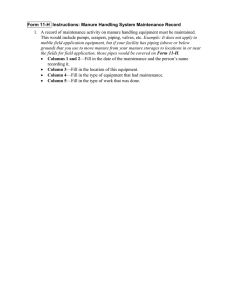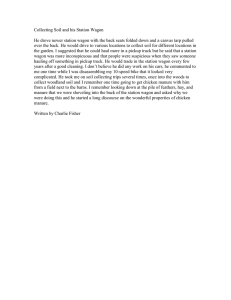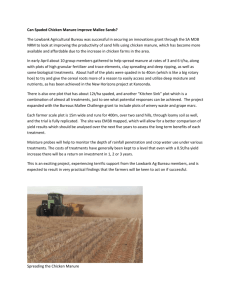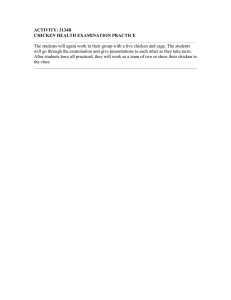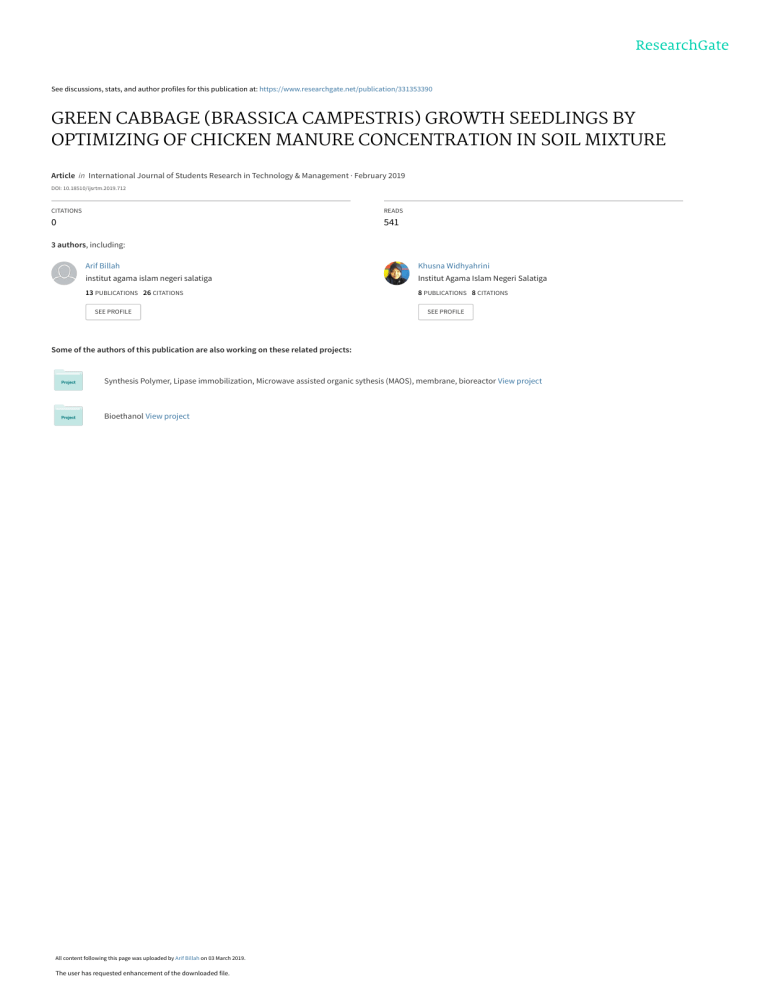
See discussions, stats, and author profiles for this publication at: https://www.researchgate.net/publication/331353390 GREEN CABBAGE (BRASSICA CAMPESTRIS) GROWTH SEEDLINGS BY OPTIMIZING OF CHICKEN MANURE CONCENTRATION IN SOIL MIXTURE Article in International Journal of Students Research in Technology & Management · February 2019 DOI: 10.18510/ijsrtm.2019.712 CITATIONS READS 0 541 3 authors, including: Arif Billah Khusna Widhyahrini institut agama islam negeri salatiga Institut Agama Islam Negeri Salatiga 13 PUBLICATIONS 26 CITATIONS 8 PUBLICATIONS 8 CITATIONS SEE PROFILE SEE PROFILE Some of the authors of this publication are also working on these related projects: Synthesis Polymer, Lipase immobilization, Microwave assisted organic sythesis (MAOS), membrane, bioreactor View project Bioethanol View project All content following this page was uploaded by Arif Billah on 03 March 2019. The user has requested enhancement of the downloaded file. International Journal of Students’ Research in Technology & Management eISSN: 2321-2543, Vol 7, No 2, 2018, pp 09-12 https://doi.org/10.18510/ijsrtm.2019.712 GREEN CABBAGE (BRASSICA CAMPESTRIS) GROWTH SEEDLINGS BY OPTIMIZING OF CHICKEN MANURE CONCENTRATION IN SOIL MIXTURE 1 Nurul Maghfiroh, 2Arif Billah, Khusna Widhyahrini3* Bachelor Student in Science Education, 2Lecturer in Science Education Tadris IPA, Faculty of Education and Teachers Training, 3*Postgraduate Program, State Institute for Islamic Studies (IAIN) Salatiga, Indonesia *Corresponding author email:*khusna@iainsalatiga.ac.id; arifbillahbadr@iainsalatiga.ac.id 1* Article History: Received on 05th November 2018, Revised on 15th February, Published on 23rd February 2019 Abstract Purpose of the study: Green cabbage (Brassica campestris) is a kind of vegetable with good quality in nutrient and economical for people. It could be planted in a small area seems like in home around. Chicken manure was the fertilizer that could get from the farming area. The productivity of Green cabbage through with nutrient in soil quality. Fertilizer was one of alternative could be done for plant nutrient by simply using to against deficiency growth. The purpose of this research is to optimize chicken manure using as fertilizer. Optimizing was done by mixture in water solvent. Methodology: Experiment was done by quantitative research in height plant analysis. The soil was taken from Joyo Imran Street Cabean region in Salatiga city that had 27C degrees in daily average. Planting was done in plastic bag consisted of chicken manure concentrations in soil at 0% (w/w); 20% (w/w); 30% (w/w); 40% (w/w); and 50% (w/w) mixture. Height measurement was done on the 10th day after planting. Main Findings: The optimum yield was obtained on 40% (w/w) mixed variation of chicken manure. It had a high increase in growing seedlings. Applications of this study: One of various fertilizers is creating chicken manure farmer using fertilizer in 40 % (w/w) mixture from chicken manure because this kind of fertilizer was better than other and had an economical. Novelty/Originality of this study: The fertilizing system had lacked in over, especially for decreasing soil quality and plant growth. Therefore, optimization of used fertilizer in the soil mixture needs to be done to see the effect. In this research optimization of the used (de Jonge et al., 2018) fertilizer in soil mix was carried out. The optimization is done to the variation of concentration of amount fertilizer to the soil in the mixture. The analysis of the growth of green cabbage was carried out from measurements height of plant that grew with 10 days. Keywords: Green Cabbage, Chicken manure, Plant growth, fertilizer, growth seedlings INTRODUCTION Green cabbage (Brassica campestris) had been used to prevent cancer, hypertension, heart disease, help digestive system health, prevent and treat pellagra disease, and avoid pregnant women from anemia[2,3]. Green cabbage was the most popular vegetable in the world, because of the economical price of other cabbage but have a lot of nutrition (Averbeke, 2007). Green cabbage gave the economic value and benefits for health, it is natural that efforts to increase mustard production continue to be carried out. Based on the Decree of the Minister of Agriculture No.511/Kpts/PD.310/ 9/2006, Green cabbage was a fostered commodity of the Directorate General of Horticulture (Regulation of the Minister of Agriculture of the Republic of Indonesia Number: 48 Permentan/OT.140/10/2009). Green cabbage could be planted in the lowlands and highlands, enough sunlight, good soil aeration and soil pH 5.5 to 6 (Jia et al., 2018). The cropping time and production area of mustard in Jambi Province in 2011 was 376 hectares and 3,410 tons, with an average yield of 9.07 tons ha-1 (Department of Food Crop Agriculture, Jambi Province, 2012), the average yield was still lower than National scale is 9.44 tons ha-1 (Indonesian Central Bureau of Statistics, 2012 and IPB Tropical Horticulture Study Center, 2012) (Pardosi & Mukhsin, 2014). Chicken manure was kind of fertilizer that used to increase the cropping product, but it had some problem. Chicken manure as a side product organic or inorganic poultry fertilizer was familiar in using by the farmer to take advantages (Bernal et al., 2009; Dikinya & Mufwanzala, 2010). Types of solid organic fertilizers that could be used to add nutrients to plants include; cow dung, horse dung, goat droppings, chicken manure, compost, vermin compost, duck manure (Ishak et al, 2016). Chicken manure had more advantages in fertilizing than the other manure, it was shown that the 10 tons of chicken manure per hectare could increase soybean production (Perkasa, Gunawan, Dewi, & Zulfa, 2016). Chicken manure waste could be mineralized to produce organic fertilizer (Arifin et al., 2006). In contrast, chicken manure with 2.3 % of Nitrogenobtained less effect than urea. The best treatment to give a high yield of Komatsuna (Brassica rapa L.) and to reduce the application of nitrogen chemical fertilizer was chicken manure to control the moisture of soil (Gazulla et al, 2013; Indriyati, 2014; Murakami et al., 2016; Ozores-Hampton, 2012). In another word, chicken manure using did not always give the economic value of crop production or quality. The quality of soil and environment, caused by inorganic compound seems like heavy metal, unbalancing of groundwater, toxicity. 9 |www.ijsrtm.in ©Authors International Journal of Students’ Research in Technology & Management eISSN: 2321-2543, Vol 7, No 2, 2018, pp 09-12 https://doi.org/10.18510/ijsrtm.2019.712 So, Chicken manure using had to be careful to get maximum crop product. In this research, Green cabbage had been treated by chicken manure to understand its effect. By optimizing in soil mixture, chicken manure would be more effective use. This aims of this research are to define the optimum for the use of chicken manure using so that there was no degradation of soil nutrient and the research was done on a small scale in order to utilize the potential around in the house. MATERIALS Some plastic glass which is used for plant growth container, the soil took from Joyo Imran Street Cabean region in Salatiga city, Central Java province. Chicken manure was taken from boiler chicken litter in Dukuh, Kopeng village of Semarang region, and watering used from the well. The Green cabbage seeds took from a commercial farming store in Salatiga city that had been selected by the traditional method. METHODOLOGY Green Cabbage Seeds Preparation Green cabbage seeds were prepared by the traditional method according to farmer usually do. The Green cabbage seeds were put into the water bath for several minutes. The sinking seeds were taken for the next process in a plastic bag with chicken manure and soil mixture. Soil Mixture Preparation The total amount of soil and chicken manure mixture was of 100 gram. The mixture was prepared by optimizing condition 0% (w/w) (control), 20% (w/w), 30% (w/w), 40% (w/w), and 50% (w/w) of chicken manure concentration in soil. The mixture was homogenized by stirring in a temperature room for 30 minutes. Planting Treatment The amount of five Green cabbage seeds were sunk into each plastic bag composed of soil and chicken manure mixture. Planting treatment was left for 10 days and checking the plant height was done in every afternoon. The Green cabbage seeds slashed in every afternoon by using well water for 10 days planting. RESULTS AND DISCUSSION Green Cabbage Seeds Preparation The sinking seeds indicate that the seeds were good quality indicated and could be planted, whereas the floating green cabbage seeds indicate that the seeds are bad and could not be planted. It’s indicated that seeds were empty and could not grow. Soil Mixture Preparation and Planting Treatment The soil mixture consisted of chicken manure and soil in variate concentration ratio. The effect of Chicken manure using could be seen in Table 1. Green cabbage seedlings growth was analyzed by its height to understand the using of concentration in some ratio. Table 1. The height of Green cabbage by chicken manure in soil mixture optimizing Mixture Ratio Chicken Soil Manure (%) (w/w) (%) (w/w) 100 0 80 20 70 30 60 40 50 50 Height (cm) 1st day 2nd day 3rd day 4th day 5th day 6th day 7th day 8th day 9th day 10th day - - 2 - 2.4 1.7 2 1.6 - 3 2 2.1 1.8 - 3.2 2.7 2.5 2.7 1.6 4 3.1 2.8 3.2 2 4.7 3.8 3.5 3.8 2.3 5.9 4.7 4 4.2 2.7 6.5 5.5 5 5 3 Height was the most factor that could be indicated about plant growth that could be indicated fertilizer useful(Adekiya & Agbede, 2016; Handayani et al., 2016; Harold F Heady, 2016; Oviyanti & Hidayah, 2016). By increasing of plant, height showed that plant got good nutrition. The Table 1 showed that Green cabbage treated with five different concentration of chicken manure in the soil mixture. The focus of calculating the height of the plant could be seen from the 6th day. By height measurement, at 6th day there are two same data, Green cabbage had 2.7 cm of height in 20% (w/w) and 40% (w/w) chicken manure concentration, and compared of the difference in height for each treatment. On the 6th day, of 1st to 6nd day showed the difference in height of 0.5 cm, then at with differences of 0.2 cm, 3rd and 4th treatment differences in the difference of 0.2 cm. Increasing doses of manure produce higher plant growth for plants because this fertilizer can increase soil organic matter and availability of nutrients so that it affects the plant height. The 4th and 5th had 1.1 cm in 10 |www.ijsrtm.in ©Authors International Journal of Students’ Research in Technology & Management eISSN: 2321-2543, Vol 7, No 2, 2018, pp 09-12 https://doi.org/10.18510/ijsrtm.2019.712 height of the differences. The difference height of Green cabbage could be seen in 4rd and 5th treatments. On the 7th day, the difference in plant height was 1.2 cm. On the 8thday was 1.5 cm, the 9th day was 1.5 cm, and the 10th day was 2cm. From all the treatment showed that concentration of chicken manure gave difference effect to Green cabbage growth. The table.1 showed that chicken manure was suitable to help plant growth in optimum concentration of chicken manure on the soil mixture. Because at a dose of 40% (w/w) with 50% (w/w) degradation of nutrients in the soil, the mustard plants grow shorter (Kusuma, 2016; Murakami et al., 2016). The degradation of Green cabbage could be caused by amount of chicken manure concentration excessive. The excessive of chicken manure concentration was understood for decreasing the quality of soil. CONCLUSION The effect of chicken manure concentration in Solvent on Green Cabbage (Brassica campestssris) Growth of Seedlings can be seen on days 6 to 10 at concentrations of 40% (w/w) and 50% (w/w) of chicken manure. There is a tendency to decrease the height of green mustard plants by 12cm by using chicken manure as fertilizer. REFERENCES 1. 2. 3. 4. 5. 6. 7. 8. 9. 10. 11. 12. 13. 14. 15. 16. 17. 18. Adekiya, A. O., & Agbede, T. M. (2016). Effect of methods and time of poultry manure application on soil and leaf nutrient concentrations, growth and fruit yield of tomato ( Lycopersicon esculentum Mill ). Journal of the Saudi Society of Agricultural Sciences, (January). Arifin, B., Bono, A., & Janaun, J. (2006). The Transformation Of Chicken Manure Into Mineralize Organic Fertilizer. Averbeke, W. Van. (2007). The commodity systems of Brassica rapa L . subsp . chinensis and Solanum retroflexum Dun . in Vhembe , Limpopo Province , South Africa, 33(3), 349354. Bernal, M. P., Alburquerque, J. A., & Moral, R. (2009). Composting of Animal manures and chemical criteria for compost maturity assessment. A review. Bioresource Technology, 100(22), 5444– 5453.https://doi.org/10.1016/j.biortech.2008.11.027 de Jonge, M. M. J., Hilbers, J. P., Jongejans, E., Ozinga, W. A., Hendriks, A. J., & Huijbregts, M. A. J. (2018). Relating plant height to demographic rates and extinction vulnerability. Biological Conservation, 220(April 2017), 104–111.https://doi.org/10.1016/j.biocon.2018.02.008 Dikinya, O., & Mufwanzala, N. (2010). Chicken manure-enhanced soil fertility and productivity : Effects of application rates, 1(May), 46–54. Fernando Gazulla, Marta Rodrigo, Encarna Blasco, M. O. (2013). Nitrogen determination by SEM-EDS and elemental analysis. X-Ray Spectrofotometry, 42, 394–401.https://doi.org/10.1002/xrs.2490 Handayani, N., Wahyuningrum, D., Zulfikar, M. A., Nurbaiti, S., Radiman, C. L., & Buchari. (2016). The synthesis of biodiesel catalyzed by Mucor miehei lipase immobilized onto aminated polyethersulfone membranes. Bioresources and Bioprocessing, 3(1), 22.https://doi.org/10.1186/s40643-016-0098-4 Harold F Heady. (2016). The Measurement and Value of Plant Height in the Study of Herbaceous Vegetation Author ( s ): Harold F . Heady Published by : Wiley Stable URL : http://www.jstor.org/stable/1931691 REFERENCES Linked references are available on JSTOR for this article : You. Ecology, 38(2), 313–320. Indriyati, L. T. (2014). Chicken Manure Composts as Nitrogen Sources and Their Effect on The Growth and Quality of Komatsuna ( Brassica rapa L .), 20(1), 52–63. Ishak, S. Y., Bahua, M. I., & Limonu, M. (2013). Pengaruh Pupuk Organik Kotoran Ayam terhadap Pertumbuhan Tanaman Jagung (Zea mays L.) di Dulomo Utara Kota Gorontalo. Journal of Applied Testing Technology, 2(1), 210–218. Jia, Y., Xiao, T., Sun, J., Yang, F., & Baveye, P. C. (2018). Microcolumn-based speciation analysis of thallium in soil and green cabbage. Science of the Total Environment, 630, 146– 153.https://doi.org/10.1016/j.scitotenv.2018.02.147 Kusuma, M. E. (2016). Efektifitas Pemberian Dosis Pupuk Kotoran Ternak Ayam Terhadap Produksi Rumput Brachiaria humidicola pada Pemotongan Pertama dan Kedua at the First and Second Defoliation. Jurnal Ilmu Hewan Tropika, 5(1), 1–6. Murakami, K., Hara, M., Kondo, T., Hashimoto, Y., Murakami, K., Hara, M., & Kondo, T. (2016). Soil Science and Plant Nutrition Increased total nitrogen content of poultry manure by decreasing water content through composting processes Increased Total Nitrogen Content of Poultry Manure by Decreasing Water Content through Composting Processes. Soil Science and Plant Nutrition, 57, 705-7–9. Oviyanti, F., & Hidayah, N. (2016). Pengaruh Pemberian Pupuk Organik Cair daun Gamal (Gliricidia sepium (Jacq.) Kunth ex Walp.) terhadap Pertumbuhan Tanaman Sawi. Jurnal Biota, 2(1), 61–67. Ozores-Hampton, M. (2012). Developing a vegetable fertility program using organic amendments and inorganic fertilizers. HortTechnology, 22(6), 743–750.https://doi.org/10.21273/HORTTECH.22.6.743 Pardosi, A. H., & Mukhsin, D. (2014). Respons Tanaman Sawi terhadap Pupuk Organik Cair Limbah Sayuran pada Lahan Kering Ultisol Response of Mustard to Liquid Organic Fertilizer of Vegetable Waste on Ultisol Dry Land. In Prosiding Seminar Nasional Lahan Suboptimal (pp. 77–83). Perkasa, A. Y., Gunawan, E., Dewi, S. A., & Zulfa, U. (2016). The testing of chicken manure fertilizer doses to 11 |www.ijsrtm.in ©Authors International Journal of Students’ Research in Technology & Management eISSN: 2321-2543, Vol 7, No 2, 2018, pp 09-12 https://doi.org/10.18510/ijsrtm.2019.712 plant physiology components and bioactive compound of dewa leaf. Procedia Enviromental Sciences, 33, 54– 62.https://doi.org/10.1016/j.proenv.2016.03.056 12 |www.ijsrtm.in ©Authors View publication stats
